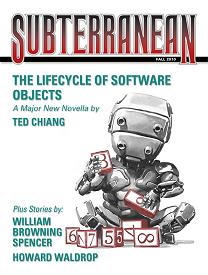
Subterranean, Fall 2010
“The Unorthodox Dr. Draper” by William Browning Spencer
“The Lifecycle of Software Objects” by Ted Chiang
“Weekdays: A Lucifer Jones story” by Mike Resnick
“Fossils” by Al Sarrantonio
Reviewed by Joseph Giddings
In “The Unorthodox Dr. Draper” by William Browning Spencer we are introduced to a psychotherapist known only as “Dr. Draper.” His methods are unorthodox in that he sometimes sleeps with his patients, asks them uncomfortable questions, or verbally berates them, all in an effort to reach that breakthrough that will help him fix their problems. However, Rachel Phelps is proving to be an enigma to him, and he begins an investigation behind her back to determine just who she is and what may have happened to her.
The story unfolds a chilling tale of a childhood gone awry. Quarreling couples, Satanists, rape, and murder fill this dark story. The story keeps you reading, giving you just enough to make you continue, wanting to know what Draper has learned now, or what is going on with Rachel. A bit slow in only a few places, this is a story well worth the time spent reading.
“The Lifecycle of Software Objects” by Ted Chiang is a deep and thought-provoking story that follows the lives of several artificial creatures, knows as digients, and the people who created them and care for them. Following a well-known pattern that software follows today, we see how the lives of their creators revolves around their digients and how they struggle to help them learn and to adapt to an ever changing world. Much like real children, they can learn and over time can make decisions on their own.
Like the next big thing, when the digients are offered for sale they are swept up by the marketplace and spread all over, but over time hackers and their like find ways to exploit the creatures, and eventually, make their own for their own purposes. As time passes the creatures become obsolete, the world they live in does as well, and their owners must find a way to help move them into the future, a proposition that requires a lot of capital to back. The owners have to make a difficult choice — do they try to sway a respectable company to pick up the project, hoping for some kind of long-term gain, or do they agree to the easier choice, letting the adult entertainment industry front the money and take the digients into the future?
It is a long story, and it drags a lot in places, but the interactions and the characters quickly endear you to them, especially the digients. My only objection to the entire story is where it is revealed that a particular character is in a lesbian relationship. It served no purpose to the story, and that character vanished right after, never to be seen again. Had she been part of the story in the future, it could’ve been relevant, but as it was I found it to be completely gratuitous.
Extremely captivating and enjoyable to read, “Lifecycle” will particularly interest people who have seen the way software moves through our world, from being the hottest thing on the market, to being the last bastion of the true diehard fans, and finally obsolescence, and the efforts the owners take to help it move on.
Mike Resnick brings us a new story in the life of his character The Right Reverend Doctor Lucifer Jones, in “Weekdays: A Lucifer Jones story.” Of course, Jones isn’t a reverend, a doctor, and hardly ever “right.” This time, Jones finds himself on an island in the Pacific, home to four, half-naked, beautiful women named after days of the week, and an old man named Caruso. Seems the old man has built quite a lot of things on the island, and he doesn’t trust Jones with the four women.
Since it is told from the perspective of Jones, the wording of the story can be a little hard to follow, since the con-man isn’t exactly the epitome of educated. But, it is a fun story of how he tries to con someone, and as a result, gets conned in the process. He does learn, though, that all that glitters is not gold.
Next Al Sarrantonio takes us along with an expeditionary group as they seek to discover long-lost evidence that humans existed in the Jurassic period, in “Fossils.” Strangely compelling, I found myself continuing to read because I wanted to know what they would find when the group finally arrived at the lost village that they sought.
Despite the intriguing material the story covers, the characters were hard to get into. Roberts is an aggressive bi-sexual female stereotype who uses sex to get what she wants. Anne is the timid and victimized female cliché. Vanessa, the main character, is flat and uninteresting. The male characters, Meyer and Porelli, only seem to exist to either have sex with Roberts or to get excited over a dinosaur skeleton. And to top it off, the ending left me less than thrilled. I read stories all the time with confusing endings and can puzzle them out with a little rereading. This time, I read the story twice just to see what I had missed. Still, the ending left me confused as to the fate of the main character, Vanessa, and why the professor, Roberts, was so angry and upset over her finding. If anything, the second read-through made me dislike the story even more.
I’m sure a lot of people will enjoy the story despite these problems, but it didn’t appeal to me in the slightest.
The Fall issue of Subterranean is a excellent read from cover to cover and, as usual, the editors pack in a lot of big-name writers who can tell a good story.